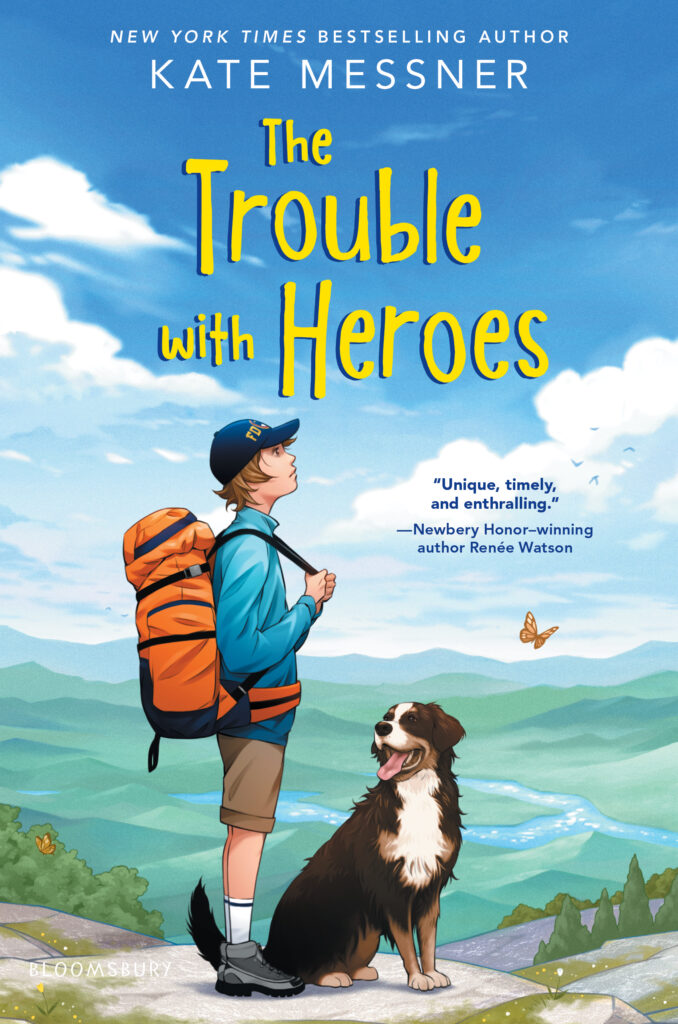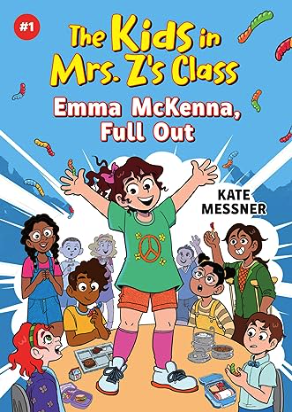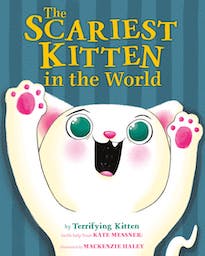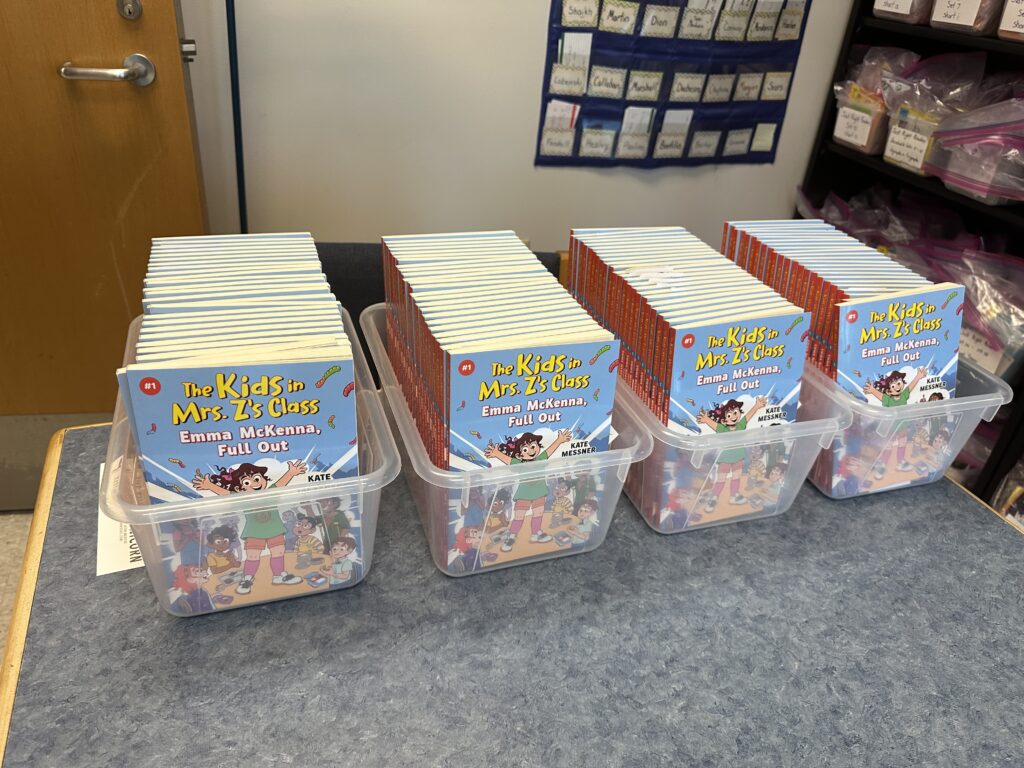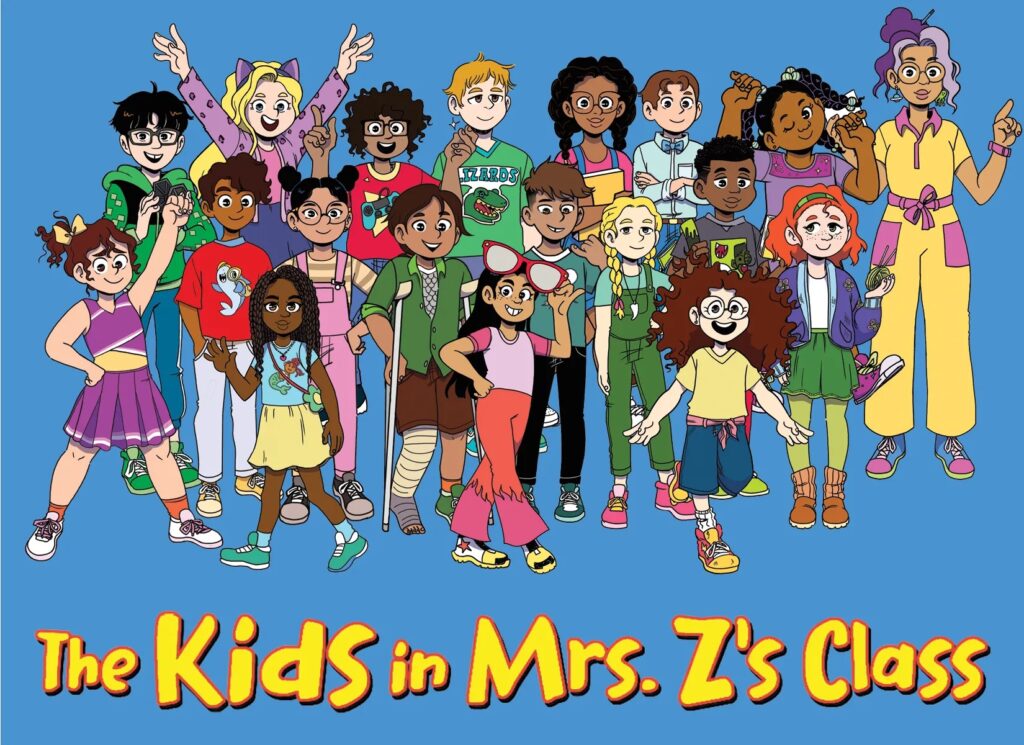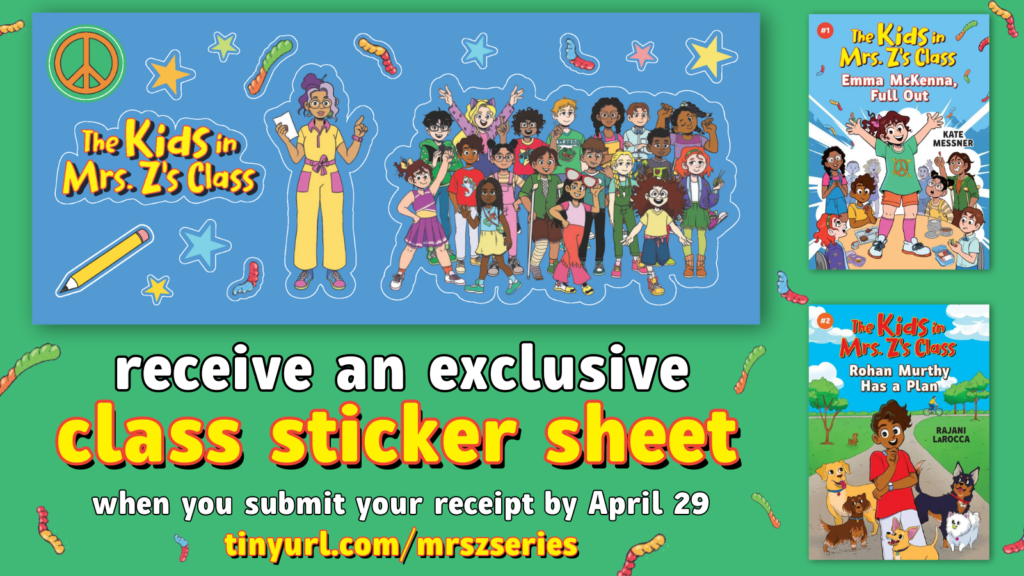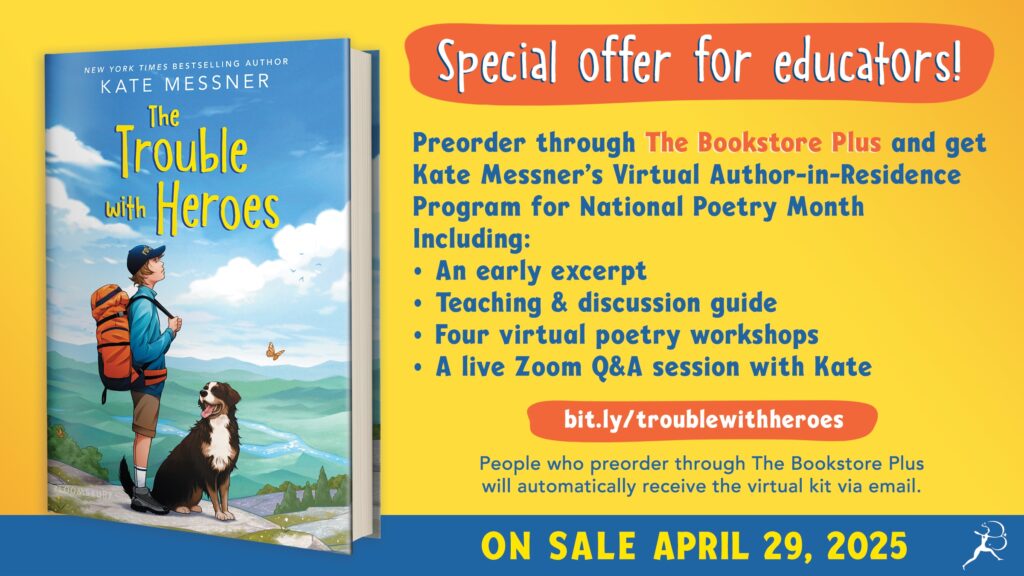
My next novel comes out this spring, and I’m celebrating with an amazing offer for schools and libraries – a free virtual Author-in-Residence program! Just pre-order a copy of The Trouble with Heroes from my local independent bookseller, The Bookstore Plus in Lake Placid, NY and you’ll get an email in early March with your invitation & resources. My 2025 virtual author-in-residence program is perfect for your National Poetry Month plans in April and includes:
- A pdf of the first 40ish pages of The Trouble with Heroes to share with students
- The Trouble with Heroes teaching & discussion guide
- Four on-demand virtual poetry workshops (10-15 minutes each), all available through June 30.
- An invitation to a live Zoom Q&A session with me in late April
- A link for families to order personalized, signed copies (delivered to your school in May)
Bloomsbury is also offering a truly unique pre-order gift for anyone who pre-orders THE TROUBLE WITH HEROES from any bookstore – a poetry notebook loaded with writing prompts to try out!
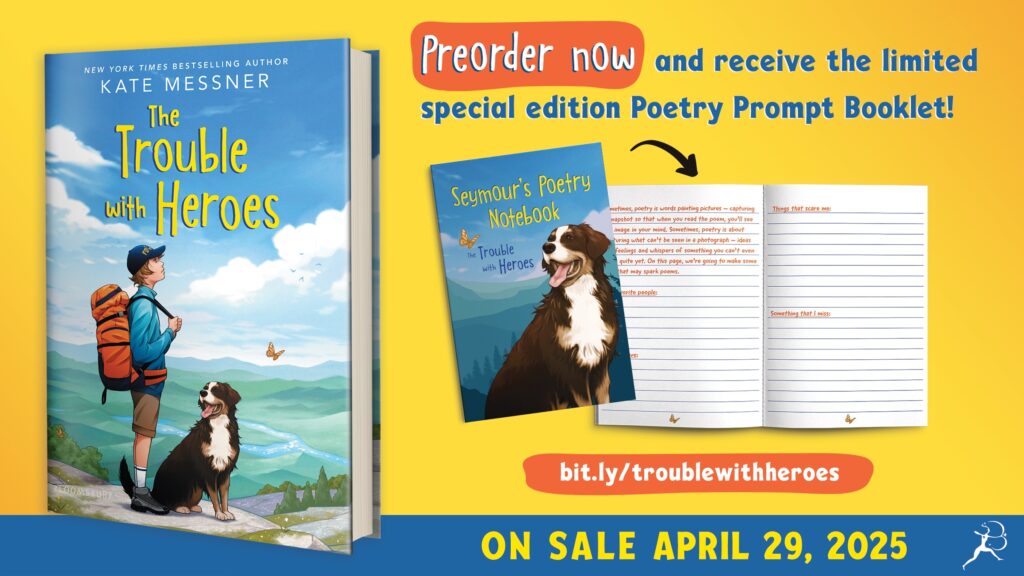
Here’s more about that offer, including a form to fill out to get your free poetry notebook!
And here’s more about the book:
Bestselling and award-winning author Kate Messner takes readers on a heart-filling journey as a boy finds his path to healing.
One summer.
46 mountain peaks.
A second chance to make things right.
Finn Connelly is nothing like his dad, a star athlete and firefighter hero who always ran toward danger until he died two years ago. Finn’s about to fail seventh grade and has never made headlines . . . until now.
Caught on camera vandalizing a cemetery, he’s in big trouble for kicking down some dead old lady’s headstone. But it turns out that grave belongs to a legendary local mountain climber, and her daughter makes Finn an unusual offer: climb all forty-six Adirondack High Peaks with her dead mother’s dog, and they can call it even.
In a wild three months of misadventures, mountain mud, and unexpected mentors, Finn begins to find his way on the trails. At the top of each peak, he can see for miles and slowly begins to understand more about himself and his dad. But the mountains don’t care about any of that, and as the clock ticks down to September, they have more surprises in store. Finn’s final summit challenge may be more than even a hero can face.

Early Praise for THE TROUBLE WITH HEROES…
Equal parts suspenseful adventure and heartrending emotion, this beautiful book will capture your heart.
~Jasmine Warga, #1 New York Times-bestselling author of A Rover’s Story and Other Words For Home
Take one drooling dog, add one pretty desperate kid, mix in mountains–a lot of mountains–sprinkle with unexpected cookie recipes and hardnosed quirkiness, and let rise. You’ll know it’s finished when the generosity and hope and truth of this novel run over. Let it.
~Gary Schmidt, bestselling author of Okay for Now and Orbiting Jupiter
Messner’s masterful storytelling is unique, timely, and enthralling in this novel-in-verse. THE TROUBLE WITH HEROES explores the heartbreak of grief and reminds us that the strongest heroes are the ones who are brave enough to admit when they are hurting. With astute intention and invention, each verse touches your soul and puts tears in your eyes—the kind of tears that comfort and heal.
~Renée Watson, #1 NYT bestselling and Newbery Honor author of Piecing Me Together and All the Blues in the Sky
The Trouble With Heroes is a compelling and deeply moving story of an angry boy who must conquer mountains both literal and metaphorical. As always, Kate Messner writes with an acute understanding of the emotional lives of today’s kids, and her respect for readers shines on every page. Messner is the Judy Blume of a new generation.
-Anne Ursu, Award-winning author of Not Quite a Ghost
You’d think a story about a young man who must climb 46 mountains in one summer would be a story of survival. This story, though, is about surviving and survivors. Pack your tissues and hold onto to your heart as Finn sweeps you into a tale that traverses the peaks and valleys of adolescence, of life, of grief, of growth. Through poetry, recipes, letters, texts, and more, Finn’s shrewd honesty and cut-to-the-bone humor creates a peak multi-modal experience for middle grade readers.
~K.A. Holt, Award winning author of House Arrest
Kate Messner, master of so many different kinds of stories, has delivered a masterpiece with The Trouble With Heroes. Part funny, part fascinating, and fully rooted in a deep emotional soul, readers of all kinds will be rooting for Finn Connelly with everything they’ve got.
~Ann Braden, Award-winning author of Flight of the Puffin
You don’t have to relish poetry to love Kate Messner’s The Trouble With Heroes, but if you do, you’re in for a special treat. This richly imagined story of grief and the great outdoors, of healing and transformation—and the reverberations of 9/11—is a layered tale, told in a refreshing variety of poetry that includes sonnets, haiku, found poems and free verse.
Messner gives us Finn, a character with attitude, swagger, and a smart mouth who also reveals emotional depth and vulnerability. Readers will not only laugh at and with him, but will undoubtedly root for him throughout. Creating a character of such complexity is something of a magic trick, and yet no wands were involved. Messner simply knows what she’s doing, and boy aren’t we glad!
Split this story like a log, and you’ll find concentric circles of metaphor and meaning on every page. There are passages that will gut you, and others that will leave you laughing out loud. The 46 Adirondack mountain peaks Finn begrudgingly ascends in this story, and the joy and healing he finds along the way—these are satisfying metaphors, indeed. Would I call The Trouble with Heroes a poem? Yes. Yes, I think I would.
~Nikki Grimes, award-winning author of Garvey’s Choice
Verse is the perfect format for Finn’s journey through the Adirondack High Peaks in The Trouble with Heroes by Kate Messner. The pitch-perfect tween voice spills out of the poetry with raw authenticity. Any tween who’s ever lost someone, made bad choices, or felt unworthy of love will identify with Finn, forced to hike the peaks as reparation for vandalism. I couldn’t put this book down!
~Kip Wilson, award-winning author of White Rose
In poems filled with humor and heart, The Trouble with Heroes is a story about the healing power of place. Finn’s journey will speak to every kid who’s felt the weight of the world on their shoulders.
~Laura Shovan, award-winning author of Takedown
The Trouble with Heroes is a heartfelt, moving page-turner that tackles grief, loss, anger and redemption. Another Kate Messner triumph!
~Dan Gemeinhart, author of Coyote Sunrise
Magnificent and moving. The Trouble with Heroes is a triumph — as healing and inspiring as the view from a mountain peak. Finn’s voice and his story will stay with me for a long time. I can’t wait to put this in young readers’ hands.
-Julie Berry, NYT Bestselling Author of Lovely War, and owner. Author’s Note, a Bookstore
I just finished The Trouble with Heroes with tears in my eyes. Adirondackers will appreciate the history incorporated into this book, but folks who have never stepped foot in our mountains will still feel right at home. A beautiful story that I will be championing in our store.
~Sarah Galvin, The Bookstore Plus, Lake Placid, NY
The Trouble with Heroes brings readers up and down the Adirondack mountains with tenderness, toughness, humor, and heroics. Messner’s poetry allows heightened access to the emotional roller coaster Finn rides while battling the unexplained loss of his father as he attempts to climb every one of the 46 High Peaks … with a slobbering dog. Positively unputdownable- with one caveat: Readers may occasionally break to test the cookies Finn bakes after reaching each summit.
~Karen Armstrong, Children’s Librarian, Lake Placid Public Library
I’m not a hiker or a dog person, but THE TROUBLE WITH HEROES makes me feel like I could be! Readers will relish every step and delicious morsel of Finn and Seymour’s journey as they grapple with obstacles both physical and mental. Messner captures Finn’s inner monologue with wit, warmth, and just the right amount of snark. THE TROUBLE WITH HEROES is a testament to the power of showing up.
~Megan Esty Butterfield, Youth librarian, Fletcher Free Library, Burlington, VT
Messner’s The Trouble with Heroes opens your heart up, breaks it into pieces, and knits it back together again. Finn’s voice is clear and true as he struggles with unimaginable loss and how to get yourself back onto the path where you belong. Strap in, you are about to embark on a journey you won’t soon forget.
– Katherine Sokolowski, 7th grade teacher.
In true Messner fashion, Finn’s story will offer company to young people who are trying to make sense of life’s complexities. The Trouble with Heroes is an artfully crafted adventure that showcases the mountains as a place of self-discovery and healing.
~Melissa Guerrette, National Board Certified educator
I read The Trouble with Heroes as my very first read of the summer and I fear I have now set myself up for disappointment. A captivating, perfectly tuned middle grade read from cover to cover. Finn’s journey is complex, as our middle grade children are, and his transformation in the subtleties is perfection. You feel his grief pour off the pages while also searching for something else to cling onto. His frustration simmers and bakes, much like the cookies that not only separated him from his dad but also provide his family’s hope. A truly meaningful read, that will go down as one of my favorite reads and one that I wish I could physically thrust into the hands of as many readers as possible to say; find yourself in these pages, surely you can connect somehow, and then go explore to seek what else you didn’t even know you needed.
~Pernille Ripp, educator & creator of the Global Read Aloud
In THE TROUBLE WITH HEROES, Kate Messner reminds us that there is no such thing as a lost cause. Through lyrical verses which capture voice and emotion, the reader meets Finn, a 7th grader, who is off balance, lost, and full of grief following the COVID-19 pandemic and the loss of his father. He now faces a future that seems unpredictable, and the reader gets to join him as he treks through learning to truly live again, even though his life will never be the same.
~ Kellee Moye, middle school librarian & 2024 ALAN President
When a teacher reads a book as wonderful as The Trouble with Heroes do they:
A) Make a curriculum connection with poetry focusing on Haikus
B) Build a unit on resilience and determination or fitness and endurance
C) Create a cooking after school activity based on the recipes Finn creates
D) Start a Social Studies Exploration on the Adirondack High Peaks
My suggestion?
E)All of the above, but only after their students have devoured it for a toppingly unique story that will have them hooked from the first page.
~Kimbra Power, the Barefoot Librarian
The Trouble With Heroes represents an emotional journey as well as a physical one. A young teen, mourning the death of his father in the post-COVID era, is tasked with hiking all 46 Adirondack High Peaks during his summer vacation. This novel in verse reads like part journal, part school poetry project, and incorporates several other media such as text messages, documents, and articles. Full of humor and heart, the layered plot offers many entry points for engagement and connection. Highly recommended for any upper elementary or middle school library or classroom!
~Rebecca Sofferman, middle school librarian, Colchester, VT
This is a story that unboxes the spaces where heartbreak and loss are contained, walks us through the darkest cloud-shadowed valleys of grief, and guides us to the highest summits of hope and healing. Kate Messner’s natural poetic voice deftly navigates the complexities of grief — unfiltered pain and heart-aching beauty — not as an experience to be repaired, but an evolution that allows it to be both released and held, left behind and found. The truth just might be that transforming a relationship with grief takes moving through it — mud puddles, insect bites, fatigue, and all — to begin to heal. One step, one hand-hold, one unpredictable path at a time, and a community of those who have traveled there before to guide the way.
~Aliza Werner, educator and consultant
Here’s where you can order your copy of THE TROUBLE WITH HEROES & claim your pre-order gifts!
